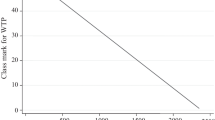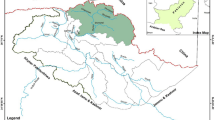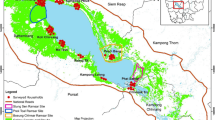Abstract
The decaying trend of the Sundarbans due to loss of habitat, lack of provision of entrance fee, absence of tourism tax, and destruction of the resource base may restrict restoration of the Sundarbans mangrove forest ecosystems. We measure tourists’ willingness to pay (WTP) and revenue stream in response to the policy change of restoration schemes on a sample of (n = 607) observations. Following the random sampling technique, well-designed dichotomous choice questions were employed to elicit stated preference (SP) data toward restoration schemes of the Sundarbans mangrove forest ecosystems in selected tourist spots in the Sundarbans. It is found that age, monthly income, and years of schooling are influential factors in determining tourists’ WTP for the restoration schemes of the Sundarbans ecosystems. The estimated WTP for the restoration schemes is Bangladeshi Taka (BDT) 64.54. Investment in restoration schemes creates a guarantee to earn BDT 11.81 billion per annum. It ensures scope to collect revenue from tourists and mobilize it for the restoration schemes. This finding is robust to various alternative data, sample, and model specifications.

Source: Prepared by the authors based on the satellite image, 2021

Source: Prepared by the authors based on Bateman et al. (2001)
Similar content being viewed by others
Data availability
The datasets used during the current study are available from the corresponding author on reasonable ground and request.
References
Agarwal, S., Anaba, U., Abuya, T., Kintu, R., Casseus, A., Hossain, S., Obadha, M., & Warren, C. E. (2019). Understanding incentive preferences of community health workers using discrete choice experiments: a multi country protocol for Kenya, Uganda Bangladesh and Haiti. BMJ Open, 9(12), e033601.
Armel, N. G. M. (2020). Identification of factors affecting adoption of improved rice varieties among smallholder farmers in the municipality of Malanville, Benin. Journal of Agricultural Science and Technology, 22(2), 305–316.
Barbier, E. B. (2000). Valuing the environment as input: Review of applications to mangrove- fishery linkages. Ecological Economics, 35(1), 47–61.
Barrio, M., & Loureiro, M. L. (2010). A meta-analysis of contingent valuation forest studies. Ecological Economics, 69(5), 1023–1030.
Bateman, I. J., Langford, I. H., Jones, A. P., & Kerr, G. N. (2001). Bound and path effects in double and triple bounded dichotomous choice contingent valuation. Resource and Energy Economics, 23, 191–213.
Bayfield. (2008). Towards an idea-centered, principle-base design to as creation approach support learning knowledge. Educational Technology Research and Development, 57(5), 613–627.
Bernal, B., Murray, L. T., & Pearson, T. R. (2018). Global carbon dioxide removal rates from forest landscape restoration activities. Carbon Balance and Management, 13(1), 1–13.
Bernardino, A. F., Nóbrega, G. N., & Ferreira, T. O. (2021). Consequences of terminating mangrove’s protection in Brazil. Marine Policy, 125(30), 104389.
Boyd, J., & Krupnick, A. J. (2013). Using ecological production theory to define and select environmental commodities for nonmarket valuation. Agricultural and Resource Economics Review, 42, 1–32.
Cenamo, M. C., & Carrero, G. C. (2012). Reducing emissions from deforestation and forest degradation (REDD) in Apuí, Southern Amazonas: Challenges and caveats related to land tenure and governance in the Brazilian Amazon. Journal of Sustainable Forestry, 31(4–5), 445–468.
Chakrabortty, P., & Eagle, A. (2017). Sundarbans tourism in disarray. The Daily Star. Retrieved from https://www.thedailystar.net/country/sundarbans-tourism-disarray-1503697.
Chen, Q., Zhao, Q., Jian, S., & Chen, P. (2018). Changes in the functional feeding groups of macrobenthic fauna during mangrove forest succession in Zhanjiang China. Ecological Research, 33(5), 959–970.
Chen, Z., Swallow, S. K., & Yue, I. T. (2020). Non-participation and heterogeneity in stated: A double hurdle latent class approach for climate change adaptation plans and ecosystem services. Environmental and Resource Economics, 77(1), 35–67. https://doi.org/10.1007/s10640-020-00434-z
Chopra, V., & Das, S. (2019). Estimating willingness to pay for wastewater treatment in New Delhi: Contingent valuation approach. Ecology, Economy and Society-the INSEE Journal, 2(2), 75–108.
Daconto, G., & Sherpa, L. N. (2010). Applying scenario planning to park and tourism management in Sagarmatha National Park, Khumbu, Nepal. Mountain Research and Development, 30(2), 103–112.
Dudley, N., Jonas, H., Nelson, F., Parrish, J., Pyhälä, A., Stolton, S., & Watson, J. E. M. (2018). The essential role of other effective area-based conservation measures in achieving big bold conservation targets. Global Ecology and Conservation, 15, e00424.
Ekka, A., & Pandit, A. (2012). Willingness to pay for restoration of natural ecosystem: A study of Sundarban mangroves by contingent valuation approach. Indian Journal of Agricultural Economics, 67(3), 1–11.
Friess, D. A., Yando, E. S., Alemu, J. B., Wong, L. W., Soto, S. D., & Bhatia, N. (2020). Ecosystem services and disservices of mangrove forests and salt marshes. Oceanography and Marine Biology, 58, 107–142.
Getzner, M., & Islam, M. S. (2013). Natural resources, livelihoods, and reserve management: A case study from Sundarbans mangrove forests, Bangladesh. International Journal of Sustainable Development and Planning, 8(1), 75–87.
Green, W. H. (1993). Econometric analysis. MacMillan.
Grellier, J., White, M. P., Albin, M., Bell, S., Elliott, L. R., Gascón, M., Gualdi, S., Mancini, L., Nieuwenhuijsen, M. J., Sarigiannis, D. A., & Van Den Bosch, M. (2017). BlueHealth: a study programme protocol for mapping and quantifying the potential benefits to public health and well-being from Europe’s blue spaces. BMJ open, 7(6), e016188.
Gurjar, U. R., Takar, S., Bunkar, K., Pathak, V., & Singh, J. (2019). Present status on distribution, biodiversity and management of Indian mangroves. Research Biotica, 1(1), 16–22.
Haab, T. C., & McConnell, K. E. (2002). Valuing environmental and natural resources. Edward Elgar Publishing.
Herr, D., & Landis, E. (2016). Coastal blue carbon ecosystem: opportunities for nationally determined contributions. Gland, Switzerland: IUCN. Retrieved from https://portals.iucn.org/library/sites/library/files/documents/Rep-2016-026-En.pdf.
Humphreys, B. R. (2013). Dealing with zeros in economics data. University of Alberta.
Iqbal, M. H. (2020). Valuing ecosystem services of Sundarbans mangrove forest: approach of choice experiment. Global Ecology and Conservation, 24, e01273.
Iqbal, M. H. (2020b). Valuing ecosystem services of Sundarbans mangrove forest for improved conservation: Approach of randomized conjoint experiment. Forestry Economics Review, 2(1), 117–132.
Islam, M. M., Sunny, A. R., Hossain, M. M., & Friess, D. A. (2018). Drivers of mangrove ecosystem service change in the Sundarbans of Bangladesh. Singapore Journal of Tropical Geography, 39(2), 244–265.
Islam, S. D. U., & Bhuiyan, M. A. H. (2018). Sundarbans mangrove forest of Bangladesh: Causes of degradation and sustainable management options. Environmental Sustainability, 1(2), 113–131.
Jones, A.M. (2000). Health econometrics. In: Culyer AJ, Newhouse JP (ed), Handbook of health economics 1: 265–344.
Kelleway, J. J., Saintilan, N., Macreadie, P. I., Skilbeck, C. G., Zawadzki, A., & Ralph, P. J. (2016). Seventy years of continuous encroachment substantially increases ‘blue carbon’ capacity as mangroves replace intertidal salt marshes. Global Change Biology, 22(3), 1097–1109.
Khan, S. U., Khan, I., Zhao, M., Khan, A. A., & Ali, M. A. S. (2019). Valuation of ecosystem services using choice experiment with preference heterogeneity: A benefit transfer analysis across inland river basin. Science of the Total Environment, 679, 126–135.
Kohlin, G. (2001). Contingent valuation in project planning and evaluation: The case of social forestry in Orissa, India. Environment and Development Economics, 6(2), 237–258.
Kolstad, C.D. (2016). Intermediate environmental economics. Oxford University Press.
Kontogeorgopoulos, N. I. C. K. (2003). Towards a Southeast Asian model of resort-based mass ecotourism: Evidence from Phuket, Thailand and Bali, Indonesia. ASEAN Journal on Hospitality and Tourism, 2(1), 1–16.
López-Portillo, J., Lewis, R. R., Saenger, P., Rovai, A., Koedam, N., Dahdouh-Guebas, F., Agraz-Hernández, C., & Rivera-Monroy, V. H. (2017). Mangrove forest restoration and rehabilitation. Mangrove Ecosystems: A global biogeographic perspective (pp. 301–345). Springer.
Maina, J. M., Bosire, J. O., Kairo, J. G., Bandeira, S. O., Mangora, M. M., Macamo, C., Ralison, H., & Majambo, G. (2021). Identifying global and local divers of change in mangrove cover and the implications for management. Global and Biogeography, 30(10), 2057–2069.
Mak, B. K., & Jim, C. Y. (2021). Contributions of human and environmental factors to concerns of personal safety and crime in urban parks. Security Journal. https://doi.org/10.1057/s41284-020-00277-9
Malik, A., Fensholt, R., & Mertz, O. (2015). Economic valuation of mangroves for comparison with commercial aquaculture in South Sulawesi Indonesia. Forests, 6(9), 3028–3044.
Mukherjee, N., Sutherland, W. J., Dicks, L., Hugé, J., Koedam, N., & Dahdouh-Guebas, F. (2014). Ecosystem service valuations of mangrove ecosystems to inform decision making and future valuation exercises. PLoS One, 9(9), 1–9.
Mukhopadhyay, A., Mondal, P., Barik, J., Chowdhury, S. M., Ghosh, T., & Hazra, S. (2015). Changes in mangrove species assemblages and future prediction of the Bangladesh Sundarbans using Markov chain model and cellular automata. Environmental Science: Processes & Impacts, 17(6), 1111–1117.
Mulwa, R., Kabubo-Mariara, J., & Nyangena, W. (2018). Recreational value and optimal pricing of national parks: Lessons from Maasai Mara in Kenya. Journal of Environmental Economics and Policy, 7(2), 204–222.
Ndebele, T., & Forgie, V. (2017). Estimating the economic benefits of a wetland restoration programme in New Zealand: A contingent valuation approach. Economic Analysis and Policy, 55, 75–89.
Needham, K., & Hanley, N. (2019). Valuing a managed realignment scheme: What are the drivers of public willingness to pay? Ocean and Coastal Management, 170, 29–39.
Nelms, S. E., Alfaro-Shigueto, J., Arnould, J. P., Avila, I. C., Nash, S. B., Campbell, E., Carter, M. I., Collins, T., Currey, R. J., Domit, C., & Franco-Trecu, V. (2021). Marine mammal conservation: Over the horizon. Endangered Species Research, 44, 291–325.
O’Connor, J. J., Fest, B. J., Sievers, M., & Swearer, S. E. (2020). Impacts of land management practices on blue carbon stocks and greenhouse gas fluxes in coastal ecosystems-a meta-analysis. Global Change Biology, 26(3), 1354–1366.
Odada, E. O., Ochola, W. O., & Olago, D. O. (2009). Drivers of ecosystem change and their impacts on human well-being in Lake Victoria basin. African Journal of Ecology, 47(SUPPL. 1), 46–54.
Okoffo, E. D., Denkyirah, E. K., Adu, D. T., & Fosu-Mensah, B. Y. (2016). A double-hurdle model estimation of cocoa farmers’ willingness to pay for crop insurance in Ghana. Springer plus, 5(1), 873.
Orlowski, J., & Wicker, P. (2016). The monetary value of voluntary coaching: An output-based approach. International Journal of Sport Finance, 11(4), 310.
Paudyal, K., Baral, H., Putzel, L., Bhandari, S., & Keenan, R. J. (2017). Change in land use and ecosystem services delivery from community-based forest landscape restoration in the Phewa Lake watershed, Nepal. International Forestry Review, 19(4), 88–101.
Pham, T. D., Kaida, N., Yoshino, K., Nguyen, X. H., Nguyen, H. T., & Bui, D. T. (2018). Willingness to pay for mangrove restoration in the context of climate change in the Cat Ba biosphere reserve, Vietnam. Ocean and Coastal Management, 163, 269–277.
Rahaman, M. M., & Iqbal, M. H. (2021). Willingness-to-pay for improved cyclone early warning services across coastal Bangladesh: Application of choice experiment. International Journal of Disaster Risk Reduction, 61, 102344. https://doi.org/10.1016/j.ijdrr.2021.102344
Rahman, M. R., & Begum, S. (2011). Land cover change analysis around the Sundarbans Mangrove Forest of Bangladesh using remote sensing and GIS application. Journal of Science Foundation, 9(1–2), 95–107.
Razzaque, J. (2017). Payments for ecosystem services in sustainable mangrove forest management in Bangladesh. Transnational Environmental Law, 6(2), 309–333.
Resende, F. M., Fernandes, G. W., Andrade, D. C., & Néder, H. D. (2017). Economic valuation of the ecosystem services provided by a protected area in the Brazilian Cerrado: Application of the contingent valuation method. Brazilian Journal of Biology, 77, 762–773.
Reynisdottir, M., Song, H., & Agrusa, J. (2008). Willingness to pay entrance fees to natural attractions: An Icelandic case study. Tourism Management, 29(6), 1076–1083.
Sage, R. F. (2020). Global change biology: A primer. Global Change Biology, 26(1), 3–30.
Sardana, K. (2018). Tourists’ willingness to pay for restoration of traditional agro-forest ecosystems providing biodiversity: Evidence from India. Ecological Economics, 159, 362–372.
Sarker, S. K., Reeve, R., Thompson, J., Paul, N. K., & Matthiopoulos, J. (2016). Are we failing to protect threatened mangroves in the Sundarbans world heritage ecosystem? Scientific Reports, 6(1), 1–12.
Sen, H. S., & Ghorai, D. (2019). The Sundarbans: A flight into the wilderness. The Sundarbans: A Disaster-Prone Eco-Region (pp. 3–28). Springer.
Sharma, B. P., Karky, B. S., Nepal, M., Pattanayak, S. K., Sills, E. O., & Shyamsundar, P. (2020). Making incremental progress: Impacts of a REDD+ pilot initiative in Nepal. Environmental Research Letters, 15, 105004.
Slemrod, J. (2019). Tax compliance and enforcement. Journal of Economic Literature, 57(4), 904–954.
Soler, L. S., Kok, K., Camara, G., & Veldkamp, A. (2012). Using fuzzy cognitive maps to describe current system dynamics and develop land cover scenarios: A case study in the Brazilian Amazon. Journal of Land Use Science, 7(2), 149–175.
Sydavong, T., Goto, D., Kawata, K., Kaneko, S., & Ichihashi, M. (2019). Potential demand for voluntary community-based health insurance improvement in rural Lao People’s Democratic Republic: A randomized conjoint experiment. PloS One, 14(1), e0210355.
Temperton, V. M., Buchmann, N., Buisson, E., Durigan, G., Kazmierczak, Ł, Perring, M. P., de Sá Dechoum, M., Veldman, J. W., & Overbeck, G. E. (2019). Step back from the forest and step up to the Bonn Challenge: How a broad ecological perspective can promote successful landscape restoration. Restoration Ecology, 27(4), 705–719.
Thompson, B. S., Primavera, J. H., & Friess, D. A. (2017). Governance and implementation challenges for mangrove forest payments for ecosystem services (PES): Empirical evidence from the Philippines. Ecosystem Services, 23, 146–155.
Valasiuk, S., Czajkowski, M., Giergiczny, M., Żylicz, T., Veisten, K., Landa, M. I., Halse, A. H., Elbakidze, M., & Angelstam, P. (2018). Is forest landscape restoration socially desirable? A discrete choice experiment applied to the Scandinavian transboundary Fulufjället National Park Area. Restoration Ecology, 26(2), 370–380.
Whittington, D. (2010). What have we learned from 20 years of stated preference research in less-developed countries? The Annual Review of Resource Economics, 2, 209–236.
Wollenberg, E., Edmunds, D., & Buck, L. (2000). Using scenarios to make decisions about the future: Anticipatory learning for the adaptive co-management of community forests. Landscape and Urban Planning, 47(1–2), 65–77.
Zambrano-Monserrate, M. A., Silva-Zambrano, C. A., & Ruano, M. A. (2018). The economic value of natural protected areas in Ecuador: A case of Villamil Beach national recreation area. Ocean and Coastal Management, 157, 193–202.
Zhang, L., Fukuda, H., & Liu, Z. (2019). The value of cool roof as a strategy to mitigate urban heat island effect: A contingent valuation approach. Journal of Cleaner Production, 228, 770–777.
Zoderer, B. M., Tasser, E., Carver, S., & Tappeiner, U. (2019). Stakeholder perspectives on ecosystem service supply and ecosystem service demand bundles. Ecosystem Services, 37, 100938.
Acknowledgements
We are grateful to the respondents that participated in the study and formed our sample for collecting and analyzing the data. We are also grateful for suggestions and comments from anonymous reviewers and journal editor.
Funding
This research received no specific grant from any funding agency in the public, commercial, or not-for-profit sectors.
Author information
Authors and Affiliations
Corresponding author
Ethics declarations
Conflict of interest
The authors announce that there is no conflict of interest.
Ethical approval
The study was supported in accordance with rules from the ethical committee of Government Edward College, Pabna.
Additional information
Publisher's Note
Springer Nature remains neutral with regard to jurisdictional claims in published maps and institutional affiliations.
Rights and permissions
About this article
Cite this article
Iqbal, M., Hossain, M. Tourists’ willingness to pay for restoration of Sundarbans Mangrove forest ecosystems: a contingent valuation modeling study. Environ Dev Sustain 25, 2443–2464 (2023). https://doi.org/10.1007/s10668-022-02140-w
Received:
Accepted:
Published:
Issue Date:
DOI: https://doi.org/10.1007/s10668-022-02140-w




